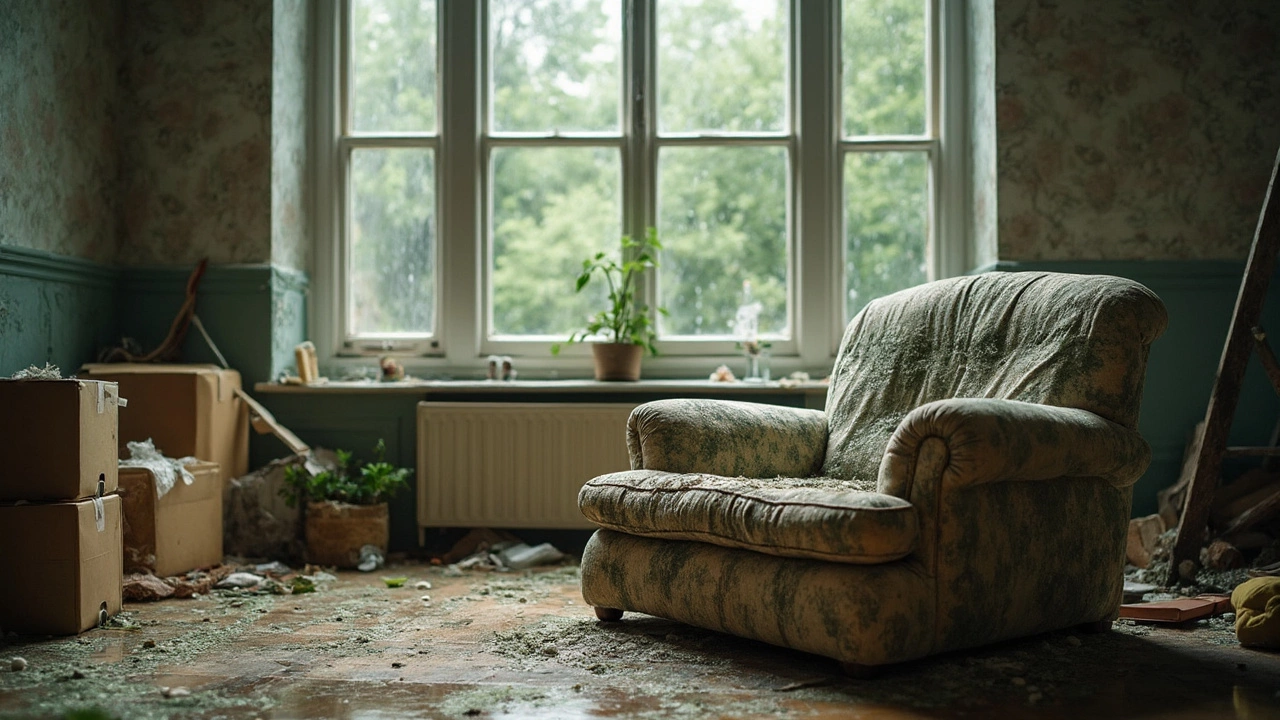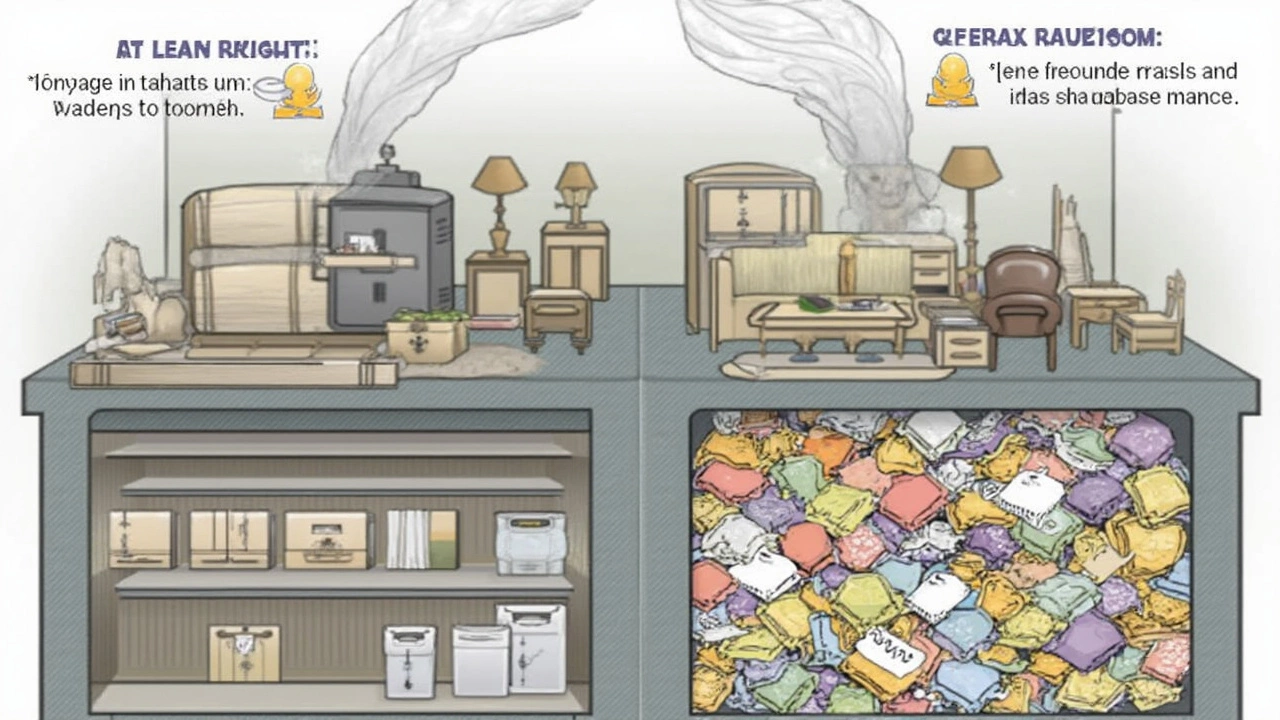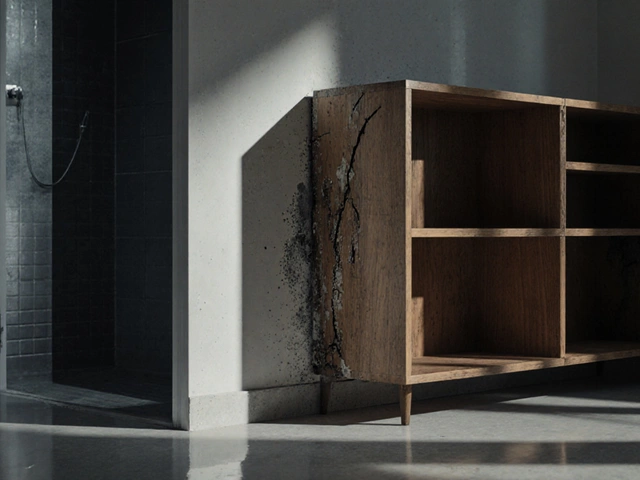 10
Jun,2025
10
Jun,2025
If you’ve ever opened a storage unit and been hit by a weird musty smell, you know it’s not just your imagination—furniture really can get moldy while stored away. Mold doesn’t care if your stuff is old or brand-new. All it needs is a little moisture and some warmth, and it’s game over for that fabric couch or wooden table.
Humidity sneaks up as the main villain here. Even in units that feel dry, climate swings can create pockets of damp air, turning your furniture’s nooks and crannies into a perfect hangout spot for mold. Some accidents don’t help either—a leaky box, a sweaty summer, or just stacking your sofa on a dusty concrete floor will all speed up the mess.
The kind of furniture matters, too. Anything upholstered, padded, or made from real wood is way more likely to soak up moisture. That’s why those old college futons and antique dressers always seem to draw the short straw when it comes to gross storage surprises. Want to learn how to dodge these problems? There’s more you can do than just crossing your fingers and hoping for the best.
- Why Furniture Molds in Storage
- Signs Your Furniture is at Risk
- Storage Conditions That Help or Hurt
- Simple Steps to Keep Mold Away
Why Furniture Molds in Storage
Mold on furniture in storage pops up for one simple reason: moisture gets trapped, and the environment lets it fester. Mold spores are basically everywhere—floating in the air, on your hands, even on the surfaces of the furniture before it goes into storage. But they only turn into a problem when they get enough moisture and a bit of warmth.
Here’s what really triggers mold in storage:
- Humidity: This is the big one. Furniture—and especially anything fabric, leather, or real wood—acts like a sponge, soaking up the dampness in the air. Anything over 55% humidity gives mold a green light to grow.
- Lack of air movement: Stuffed storage units and homes with everything pressed together trap pockets of moist air. With nothing moving, mold has a field day.
- Temperature swings: Warm days and cooler nights make condensation form inside units or on unprotected furniture surfaces. Water droplets might be invisible, but mold loves them.
- Contamination: Sometimes, furniture goes into storage already holding tiny mold spores, pet dander, or sweat from use. Give those spores a little moisture later, and you’ll get mold stains or a funky smell.
Check this out—here’s what experts say about the best and worst conditions for storing your stuff:
| Factor | Safe Range | Risky for Mold |
|---|---|---|
| Humidity | <50% | >55% |
| Temperature | 60–75°F | >80°F |
| Air Circulation | Good, with space | Packed tightly |
The tricky part? A lot of storage places aren’t climate controlled. According to the Self Storage Association, about 60% of storage units in the U.S. are non-climate-controlled. So, if you just toss your couch in and forget about it, you’re rolling the dice, especially if you live somewhere humid or with big weather swings.
Bottom line: Mold isn’t picky. Give it a bit of moisture, some warmth, and just a dash of neglect, and you’ll be cleaning fuzzy green or black stains—or tossing your stuff out entirely. Knowing this stuff up front saves a ton of headache later.
Signs Your Furniture is at Risk
Catching the warning signs early can save you a lot of time, money, and headaches. Mold on stored furniture isn’t always as obvious as big black patches. Sometimes, it’s sneaky—hiding in seams, under cushions, or showing up as a faint smell before you see anything.
Here’s what to watch for if you’re worried about moldy furniture in storage:
- Musty Smell: The first clue is often a weird, earthy odor on your stuff. It’s like wet socks or dirt—never a good sign.
- Discoloration: Check for stains, spots, or splotchy areas, especially on fabric and wood. Greenish, black, or even whitish fuzzy patches are the usual suspects.
- Sticky or Damp Spots: Mold loves moisture. If anything feels even a little damp or tacky, trouble could be brewing.
- Soft or Warped Wood: Wood that starts to feel spongy, bowed, or crumbly has probably been fighting off moisture for a while.
Padded or fabric furniture and real wood pieces are the most common victims. Vinyl, glass, and metal usually don’t mold, but they aren’t immune if dirt or organic stuff is left on them.
| Furniture Type | Common Signs of Mold | Risk Level |
|---|---|---|
| Upholstered/ Fabric Couches | Odor, stains, fuzzy spots under cushions | High |
| Solid Wood Tables/Chairs | Black spots, warping, rough texture | High |
| Veneered/Pressed Wood | Peeling veneer, swelling, softspots | Medium |
| Leather Furniture | White powder, crackling, mildew smell | Medium |
| Metal, Glass, Plastic | Rust (metal), dirt clinging to mold | Low |
If your stuff checks even one of these boxes, it’s time for a closer look or a cleanup. Don’t just shove it back in storage—mold spreads fast, and it only takes about 24–48 hours for it to grow if the conditions are right. Being proactive can make all the difference when it comes to keeping your furniture storage safe and mold-free.

Storage Conditions That Help or Hurt
The way you store your furniture can make or break its future. If you just toss stuff into a garage or a basic unit and shut the door, you’re rolling the dice with mold. Mold isn’t picky, but it loves dark, still air, damp floors, and wild temperature swings. So, what conditions actually matter?
Temperature and moisture are huge. Mold wakes up and starts partying when humidity hits around 60% or higher. Plain old garages, basements, and outdoor sheds often have no control over these numbers. That’s why people paying for climate-controlled storage units aren’t just being fancy—they’re dodging a real problem.
| Condition | Effect on Mold Growth |
|---|---|
| Humidity below 50% | Slows or stops mold |
| Temperature at or below 68°F (20°C) | Mold grows slower |
| No airflow/stale air | Mold grows faster |
| Outdoor sheds/garages | More likely to get mold |
| Basements | Risks rise if not dehumidified |
| Climate-controlled storage | Best option for protection |
Direct floor contact is another big offender. Placing a wooden chair or mattress straight on concrete invites condensation and lets moisture creep right in. Using pallets or even old boards keeps furniture off the ground and away from trouble.
- If you nail just one thing, make sure to check the humidity levels where you’re storing stuff. If you don’t own a humidity gauge, they’re cheap and easy to grab online or in most hardware stores.
- Regular checks save furniture. Swing by your storage every few months, especially in the damp seasons. Look for signs like water stains, sticky surfaces, or a funky smell.
- If you can, pick a place with furniture storage options offering climate control. Your furniture won't just survive storage—it’ll come out smelling fresh.
Simple Steps to Keep Mold Away
If you really want to keep your furniture storage mold-free, there are some straightforward things you can do right now. The key is making conditions mold hates—dry, breezy, and clean.
Start with these must-dos before you move anything into storage:
- Clean everything first: Dust, crumbs, and stains can actually feed mold. Use mild soap and water instead of harsh chemicals that can damage surfaces. Wooden furniture dries slower, so let it air out a full day before you store.
- Dry is non-negotiable: Never put damp pillows, cushions, or wood in a storage unit. Even a tiny bit of leftover moisture gives mold a head start. Run a fan, open some windows, or use a hair dryer for bits that won’t dry fast enough outside.
- Wrap smartly: Avoid plastic wrap on soft furnishings—it traps moisture. Use breathable covers or clean cotton sheets to keep dust off. For wood, blankets or moving pads work best.
- Choose the right storage spot: Look for places with climate control. If that’s not possible, try to keep your stuff away from external walls and off the ground with pallets or risers.
- Add moisture control: Toss in silica gel packs, moisture absorber tubs (like DampRid), or even a box of baking soda. They’ll help suck up extra wetness from the air.
- Don’t pack in tight: Airflow is your friend. Leave room between each piece so air can get around. Stacked items trap air and can heat up, making stuffy spots that mold loves.
- Visit and check: Open your storage up every month or so. Look for new smells, strange spots, or beads of water. If anything feels damp, dry it out right away and maybe swap in fresh moisture packs.
Some quick numbers can help you see why this matters. Mold grows fastest when humidity is above 60% and the temperature is above 77°F (25°C). Here’s a quick glance at what you’re up against:
| Condition | Mold Risk Level |
|---|---|
| Humidity below 50% | Low |
| Humidity 60-80% | Moderate to High |
| Temp below 70°F (21°C) | Lower |
| Temp above 77°F (25°C) | Much Higher |
The bottom line? A few easy habits and checks can save you loads of hassle, cash, and gross smells in your storage unit. Protecting your stuff is totally doable—you just need to stay one step ahead of the mold.




